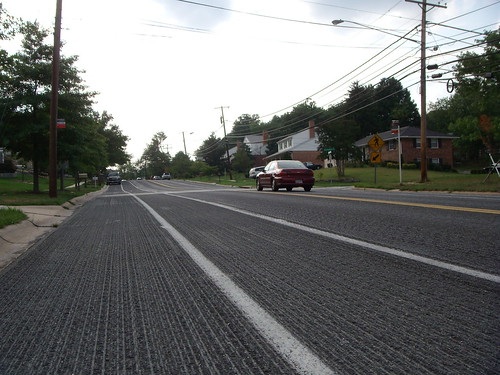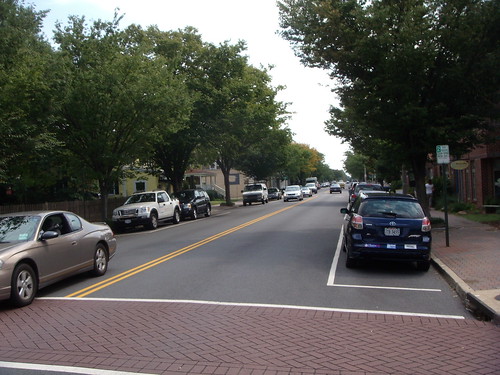 One Calverton resident says street trees make Calverton Boulevard, above, unsafe for pedestrians.
One Calverton resident says street trees make Calverton Boulevard, above, unsafe for pedestrians.At what point do trees go from being oxygen- and shade-givers to being silent killers? When they're street trees, apparently. A week ago, we wrote about County Executive Ike Leggett's recommendations for the new Road Code, which attempts to make MoCo roads friendlier to pedestrians and bicyclists in addition to cars. One of Leggett's biggest suggestions - and the one that's become the most controversial - is the removal of trees adjacent to traffic, which he considers very dangerous.
Two letters in this week's Gazette discuss the perils of street trees. AAA Mid-Atlantic Chairman Lon Anderson says that street trees and narrower lanes are more trouble than they're worth - and that the Planning Board's hit a "new high in its arrogance" for endorsing them instead of the County Executive's suggestions:
While narrower lanes may slow traffic, they also provide less margin for driver error, and we all know drivers make errors. In narrower lanes, errors lead to more crashes, just as more trees close to the roads also limit space for driver errors that can — and regularly do — lead to serious and fatal crashes.Calverton resident Larry Reynolds says that trees impair his ability to see cars coming down Calverton Boulevard, which he walks on "several times a day":
I must step into the road before I can see if any vehicles are coming. The same is true for drivers pulling out of either of those streets. I have almost been hit several times . . .so much more AFTER THE JUMP . . .
 Mount Vernon Avenue in Del Ray, Alexandria.
Mount Vernon Avenue in Del Ray, Alexandria.Anderson cites "driver error" as a reason why narrower lanes are dangerous. But if motorists are forced to drive slower, aren't the risks of "driver error" reduced - not only because they can react quicker, but because they can do less harm in a car that's going twenty-five miles an hour rather than forty?
And I'm not surprised that Reynolds has come close to being roadkill, but it has nothing to do with trees blocking his sight (which the County could fix with a little pruning.) Calverton Boulevard is five minutes from my parents' house, and I can tell you: people drive way too fast on it, myself included. The road is wide for a neighborhood street, and visually made wider because very few people park along it; it's fairly straight, and completely downhill if you're coming west from Cherry Hill Road. This is a design that encourages speeding, even with speed cameras. Talk about driver error! If you're going sixty (twice the posted limit) on Calverton, anything in your way is done for.
Compare this to Mount Vernon Avenue, a street in the Del Ray neighborhood of Alexandria, where I'm designing an infill project in my Studio class. Not unlike Calverton Boulevard, "the Avenue," as it's called, handles a lot more traffic than it was intended to as a neighborhood street, but with a lot less grief. Why? Well-used street parking and street trees visually make the road narrower and force drivers to slow down to about twenty-five miles an hour. I can cross Mount Vernon Avenue anywhere and not worry, because the cars can see me coming and I can see them coming, even with street trees. You'll find a lot of people on foot here, not just because it's a commercial street, but because it's a safe and attractive place to walk.
The odds are very high that street trees and narrower lanes will make a car slow down. What are the chances of "driver error" resulting in a deadly crash? As we found out in the tragic death of two ninety-two-year-old friends in a car-tree collision on Norbeck Road last month, those odds do exist. But why should we design our roads for extremely rare circumstances at the expense of a better daily experience for its users - not only motorists, but pedestrians and bicyclists as well.

9 comments:
Guns don't kill people, street trees do. This stuff makes me hopping mad!
It is similar logic to the fact that complicated intersections are less likely to have traffic accidents because drivers slow down and are more aware at those intersections. In 28 years, I have never seen an accident at Colesville Road and 16th Street, one of the most confusing intersections in the area. I've also never seen traffic really backed up there.
It is one of the basic concepts of urban planning, get drivers to slow down. Visual cues are the most effective way to do this. Leggett's proposal is highly illogical.
Is anyone actually surprised that the Gazette prints letters from shills touting "Ike" Leggett's sinister plot to make the streets unpleasant for the tanless and pale? Maybe he's heavily invested in parasol manufacturing and wants a bigger dividend check at the end of the month, which is about the only sane and non-racist explanation for his evident declaration of war against us palefaces.
Or look at it another way: When the sun's at high noon, there's a nice shade tree on the no-mans-land that keeps the poor folks waiting for the "48" from getting too hot in the summer sun. But because it's properly trimmed, it doesn't block their view of the oncoming bus nor does it obstruct people's view of the "Stop" sign. What block's people's view of that "Stop" sign is the placement of the Ride-On bus-stop sign, which is placed perfectly to break up the pattern of the Big Red Octagon.
Whoever this person is who complains about having to step out into the road to see around the trees should stop trying to cross the road in the middle of the block on a curve, and cross at the intersections as the law should require.
Oh, I just thought of another explanation for this bizarre war against sidewalk shade trees. After a decade or so of neglect, PEPCO and the County had to join forces to trim up a couple of trees here that had inexplicably been planted right next to the utility poles on which streetlights were mounted. The trees had grown out in such a way that their foliage was blocking the light from reaching the ground.
Thus, if there's any public-safety concern at all, it's for bad placement of streetlights and shade trees which obviously shouldn't be right next to each other. But this has absolutely nothing to do with automobile traffic on the streets. Explaining it as if it were a pedestrian/traffic safety issue is simply more of the typical rationalization and obfuscation of trying to save a very few bucks trimming trees.
And that's the real problem in a nutshell: shifting blame where it doesn't belong, and submitting rationalizations so bizarre that no logical person can figure out how to argue against them (because everyone knows you can't argue with a sick mind).
Yeah....trees kill and also, what did Ronald Reagan once say? Ketchup is a vegetable?
Slowing drivers down, planning for "road diet" etc. is good for all. Did Legett really propose removing urban tree canopy? Yikes!
I grew up on MoCo anjd visit often, but I now reside in Annapolis where I publish the only political blog from within the city limits--www.annapoliscapitalpunishment.blogspot.com
I like the excec's overall intentions to promote and protect walkers, but...
Well, you can fit more people into Maryland if you Pave the Bay, and I guess you can clear enough space for all of those people to walk if you clean out the Urban Forest.
Maybe this is more of what Our Humble Host derided as "letting cops control urban planning". After all, can't have trees getting in the way of surveillance by unmanned aerial drones.
Let me get this straight - we are going to remove the trees, but not the power poles?? Power poles kill too, and on many streets the power poles are closer to the roadway than are the trees.
Nope, just the trees.
All I can say about this is that I live in a neighborhood that was once known as "Wheaton Woods".
We bought the place we live in because it had lots of shade trees, and was a nice sub-Urban Forest.
Almost all of our neighbors who bought at the same time made their final decision mostly on the basis of the place being forested. Not surprisingly, a lot of the people buying here for that reason had ancestry in or near the Schwarzwald or comparable vestiges of the Hercynian Forest.
In later years, we noticed that the new wave of foreigners immigrating from places other than Europe tended to buy a property and immediately cut every tree on the property, after if not before they were informed that it was their responsibility to remove the deciduous fall and get it to the curb for collection.
Maybe "Ike" is simply bowing to the demands of lazy immigrants who don't want to be bothered collecting the fallen leaves of the trees which make our county so liveable.
All I can say is that I'm not too happy if that's the real reason; I mean, these people deforested the Amazon and after cutting down every last tree in their homelands and turning them into deserts, they want to come here and do the same thing and make our country unliveable as well.
Dan,
Speaking of Calverton Blvd: I live right by there and travel that road most days. I see the "Photo enforced" signs, but I'm failing to see the cameras. Where are they located? And are they only pointed in the direction coming from Cherry Hill?
There actually aren't any permanent speed cameras on Calverton Boulevard. Instead, the County has mobile van-mounted speed cameras that rotate between it and a number of other "photo-enforced" roads. I'm not sure if this is a temporary measure before cameras are installed on every road, though mobile speed cameras do seem pretty effective - you never know when the van's going to be there, so people do slow down.
Post a Comment